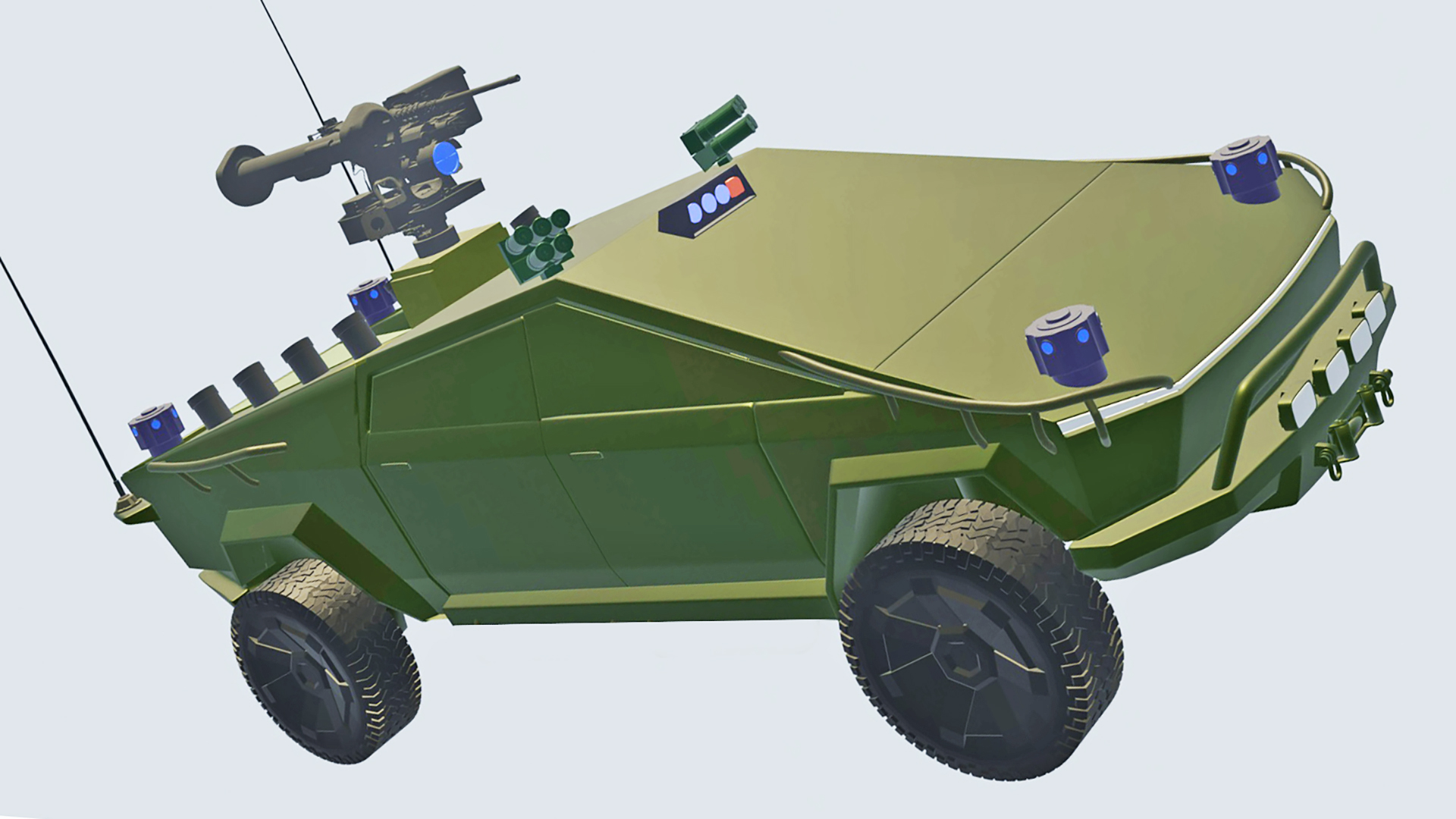Elon Musk’s Cybertruck is like the ultimate technological Rorschach test — everyone sees something different in it, and that comes with a lot of emotion. I guess that’s what art is supposed to do, elicit an emotional response, for better or worse, and cars can be very much that — art. But after following the stainless steel wedge of a vehicle’s saga over the years and recently learning about its actual technological breakthroughs and capabilities, it quickly dawned on me that the Cybertruck has remarkable baked-in military potential, especially in one specific emerging capability set. I will go even a step further and say it seems as if it was designed with this in mind, although I know it was not. And, in many ways, military service would be agnostic to some of the biggest, albeit still contentious, concerns and criticisms surrounding Cybertruck.
Simply put, the potential for Cybertruck to become an uncrewed ground vehicle (UGV) is unlike anything I have seen before from the commercial marketplace, and that presents a massive opportunity for the Department of Defense and Tesla.
UGV is basically a term for a land vehicle drone and spans a huge spectrum of potential capabilities, from small rovers to light utility transports to remote mobile missile launchers to unmanned ‘mini-tanks.’ For Cybertruck, we are likely talking about a UGV in the light utility category, which can take on many roles.

The Army and Marines want UGVs, including for manned-unmanned teaming, to dominate future land battles, with all the benefits and potential challenges that come with such a vision. The Pentagon is eyeing UGVs for non-combat roles, too. There are also civilian and commercial applications for UGVs, but it’s the DoD that could really take advantage in the near term of Tesla’s huge investment in developing the Cybertruck platform.
The idea that the Pentagon could potentially capitalize on mass production of Cybertruck, and all the associated infrastructure, sustainment work, and grand economies of scale that would come with it, makes for a relatively unprecedented and timely opportunity.
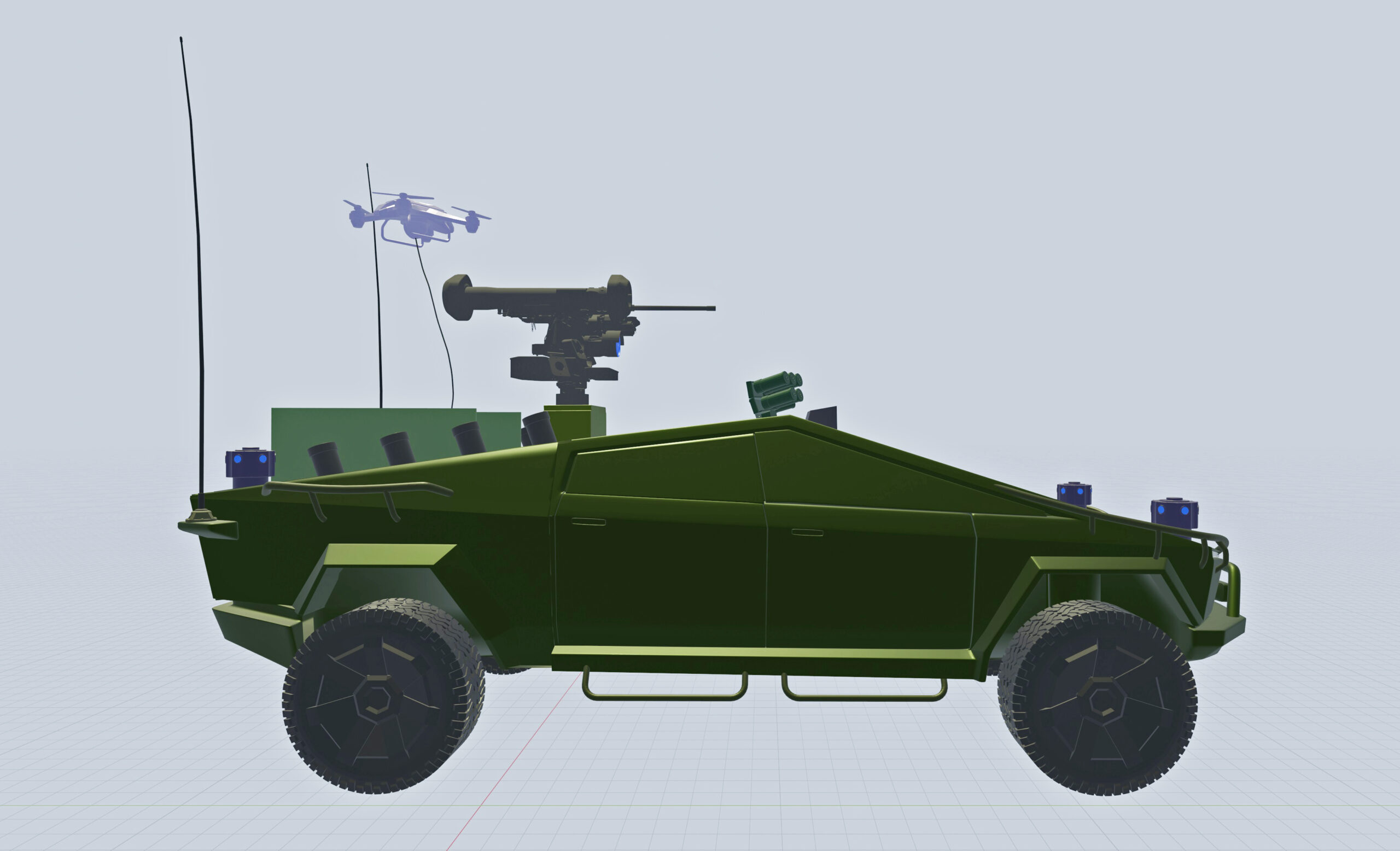
A military Cybertruck without a human driver
Let’s get this out of the way. Yes, Cybertruck looks like a futuristic assault vehicle out of a dystopian science fiction movie. That’s the entire point! There has already been plenty of fan art and memes of it equipped with a Gatling gun and military modifications like those of the famed ‘Warthog’ from the Halo video game franchise, for instance. The utility that the real Cybertruck could provide the military does not lie in its futuristic ‘battle wagon’ looks. It’s in its underlying design features and technological innovations.
Cybertruck has an uncanny number of attributes that make uncrewed applications for it uniquely attractive and potentially very cost-effective. Its large battery means that it can sit on station for long periods of time without consuming fuel or making noise. This is very important for uncrewed ground vehicles that operate forward, from austere locations, for long stretches, acting as remote weapons and sensor platforms or as security sentries. A major expansion in battery capacity could be added to further extend its ability to persist on the battlefield, especially with the space and payload currently reserved for humans freed up.
Cybertruck’s robust suspension and rigid body could be a benefit to UGV applications. Tweaks would be made to better support off-road operations, as well. The aftermarket is currently developing kits for this, but the truck already has good ground clearance unimpeded by axles. These attributes can be improved upon significantly with relatively minor alterations aimed at military-specific applications and free from the demands of passenger car regulations.
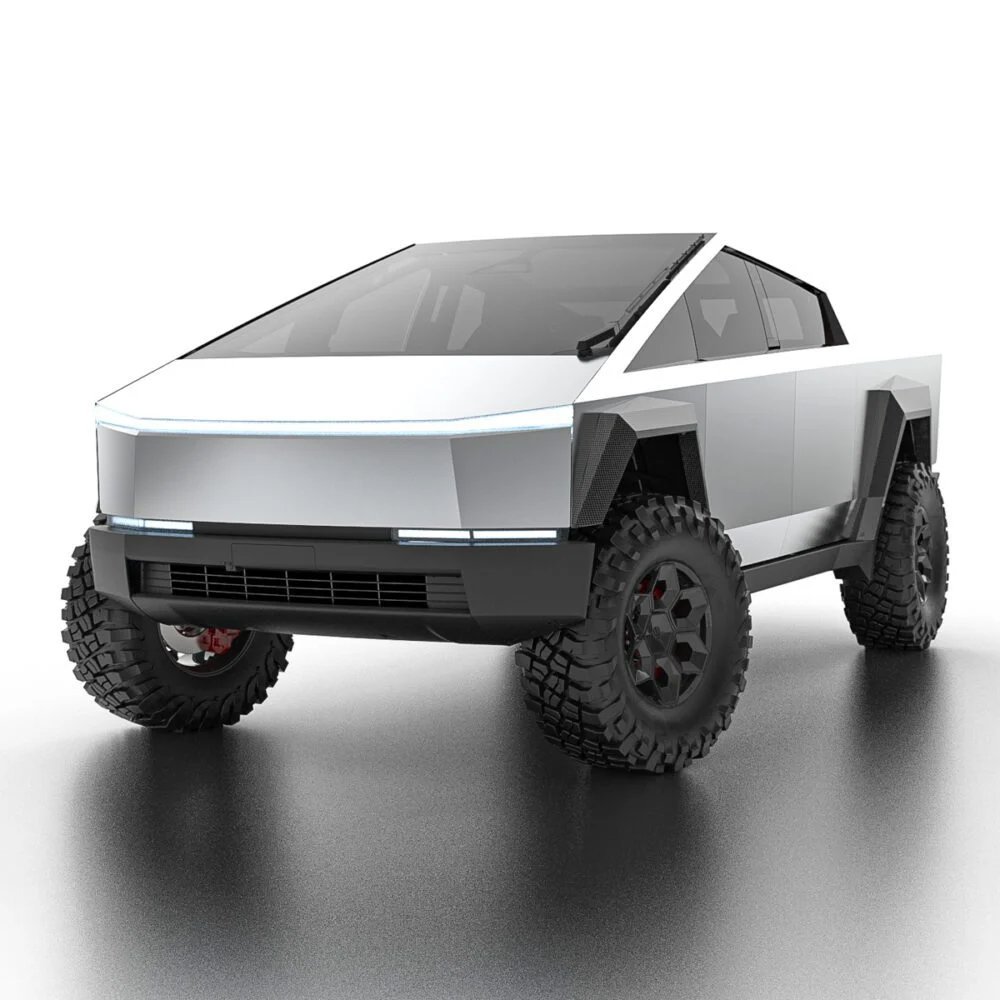
The vehicle’s driving characteristics are heavily software-defined. This programming can be tweaked to tailor the truck’s abilities to the environment it is operating in. This goes a step beyond the different driving modes found in most 4X4 and all-wheel-drive vehicles. For instance, Cybertruck features ‘wade mode’ that maximizes ride height and pressurizes the battery pack allowing it to traverse some rivers and large streams. Musk claims he is working to make Cybertruck perform like a true amphibian, acting as a boat for crossing small bodies of water with minimal modification. How realistic it is to actually do this remains to be seen, but there are already modifications that have been made to Cybertrucks that provide a glimpse of potential ‘exotic’ configurations to come.
Yet it’s Cybertruck’s full ‘steer-by-wire’ capability that is arguably the most attractive feature in terms of turning it into a UGV. The vehicle has no mechanical linkages between the steering system and the driver’s wheel. Driver inputs are interpreted by the computer and then sent to its four-wheel steering system — also a huge plus for a larger UGV operating in tight spaces.
Steer-by-wire is a major automotive revelation for a vehicle intended for mass production — Cybertruck is the first to achieve such a feat. This is especially attractive for unmanned applications. Control inputs could be handled and applied without manipulating legacy mechanical steering systems that exist on every other production vehicle, allowing for seamless uncrewed integration. Commands would go right from the computer to the electrically driven steering system. This eliminates bulk and mechanical complexity, latency, and more, as well as opening up space for new design possibilities.
What makes its steer-by-wire concept possible is the vehicle’s 48-volt power system, which is also relatively novel for a production car. It can provide high amounts of power throughout the vehicle efficiently while saving lots of copper wiring and weight. Having a built-in power handling system of this capability is also extremely attractive for military applications that would use sensors and weapon systems that suck up a lot of power. The ability to integrate some of these systems directly into the truck’s existing power management system could be a boon and would allow for easier integration of new components and technologies.

Instead of a heavy wiring harness with individual wires controlling and supplying power to the many components on the vehicle, Cybertruck uses an Ethernet network to carry data across the vehicle, greatly simplifying its wiring harness. This could be a huge opportunity for military applications as a true ‘open architecture’ approach to integrating militarized components and additional systems could be possible without additional wiring and deep modification. This could drastically decrease the time and investment it would take to add new capabilities. This open architecture concept is a critical component of virtually all new platforms the DoD is pursuing today and its foundation is already built into Cybertruck.
Updates to Cybertruck’s driving system could potentially be sent to the vehicle wirelessly to better tackle whatever terrain is in the area. Theoretically, updates could also be sent to the sensor and other payload packages the vehicle could support, although it would need to be done via a secure waveform and interfaced with the onboard computer. The vehicle’s Ethernet databus would be able to carry that information to any system plugged into it. Being able to send updates via secure datalink in near real-time is a key advantage the DoD has looked to deploy for various applications across different platform types.
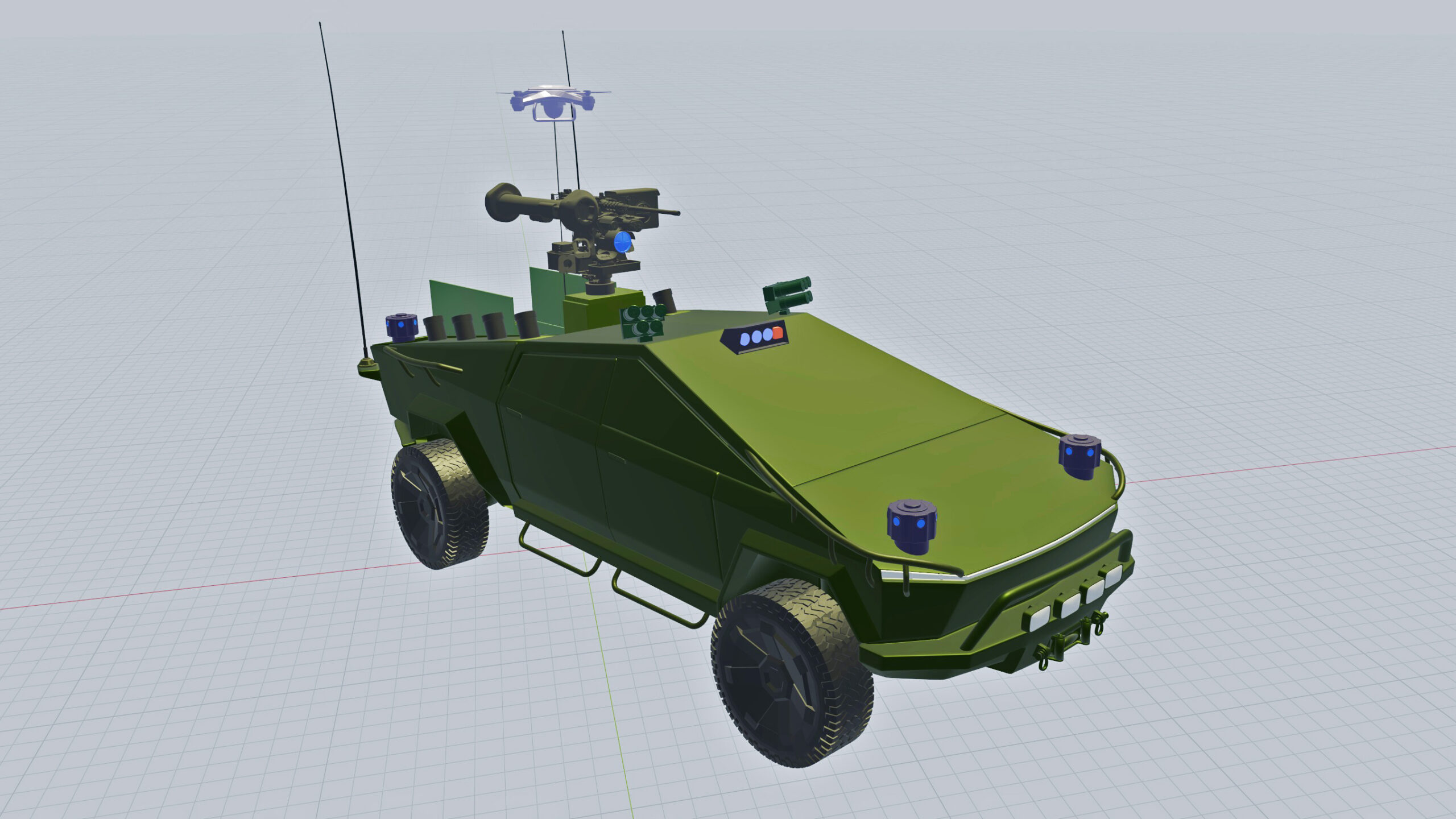
Tesla is a leader in autonomous driving and the machine learning/artificial intelligence (AI) that supports such emerging capabilities. Once again, leveraging this experience — including millions of hours of real-world driving data — and the self-driving systems already installed on Cybertruck for autonomous operations would be a huge advantage for UGV applications. It could also help Tesla better evolve these capabilities for the road, considering the unique and highly challenging environments military UGVs would be operating in. The self-driving systems already installed in Cybertruck could be augmented with additional sensors and other hardware for UGV applications.
Regardless, just having Tesla as a partner for accomplishing autonomous UGV operations over a broad range of scenarios would be a huge plus for the DoD and investments made by the Pentagon could be leveraged in Tesla’s commercial applications.

A Cybertruck UGV does not need a cabin. Since there are no steering linkages that go into the cabin, it can be eliminated entirely. Optionally manned is another possibility, but using the entire cabin’s volume for additional equipment, cargo, missionized payloads, and more batteries is entirely possible. Rethinking the cabin area, or eliminating it entirely, opens up a ton of new possibilities.
Considering there is also a ‘frunk’ in the Cybertruck, a drone version of it would open up payload compartments from the tailgate to the front bumper. A battery pack is already in the works that could extend the range of Cybertruck 38% by taking up 33% of its truck bed. One can only imagine how much battery capacity could be added without a need for a cabin at all.

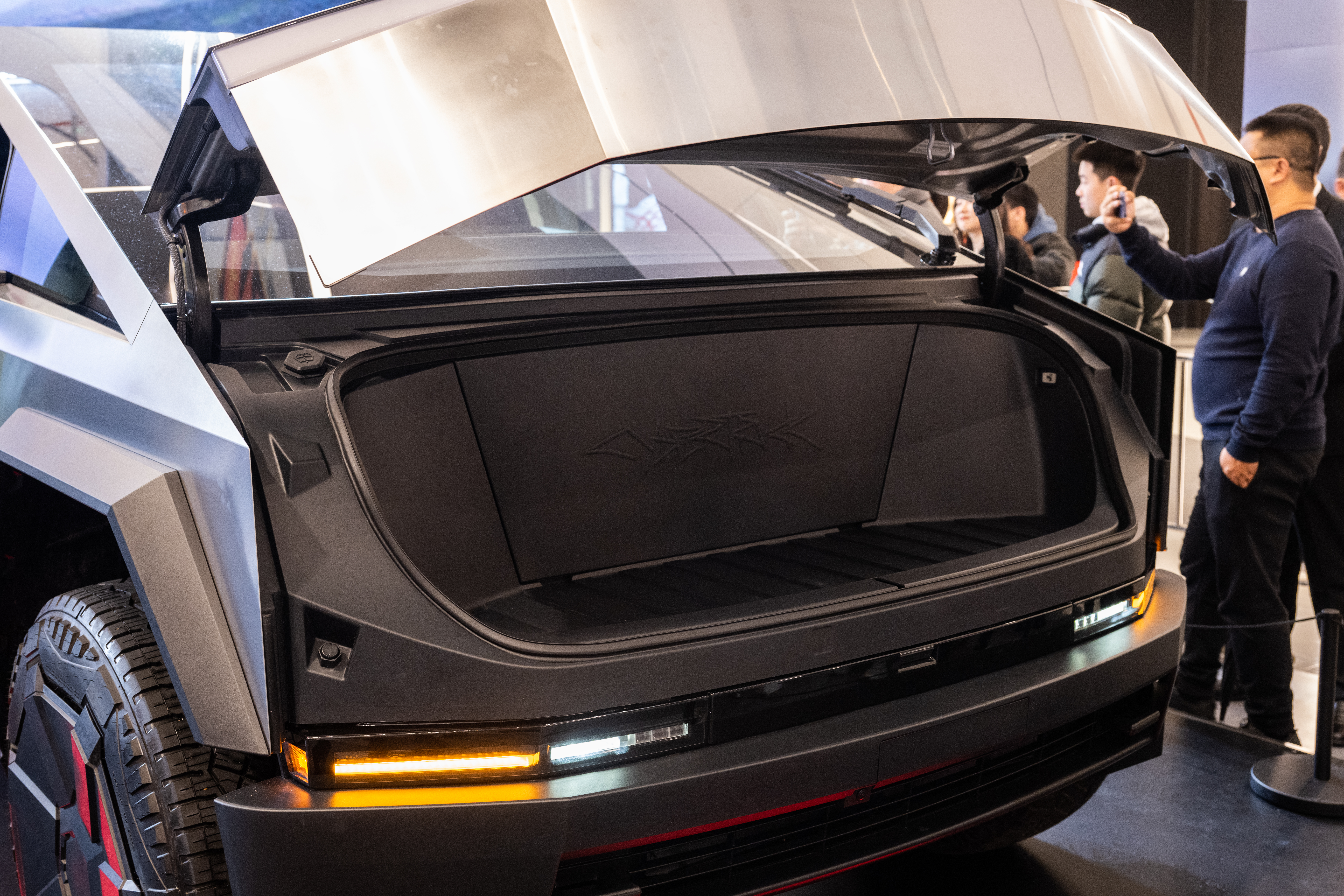
Cybertruck’s bed area could support a huge range of payloads, from drone launchers to a remote weapons station to directed energy systems (lasers, high-power microwave weapons, etc.) to casualty evacuation enclosures.
It may also be possible to just leverage the truck’s ‘skateboard-like’ lower core and put an entirely new body on it optimized for UGV missions, although this would require an exoskeleton (unibody) frame of its own. While this could be an enticing option, taking the Cybertruck as closely off the production line as possible and adapting it to UGV uses is the key to tapping into true economies of scale and making development and sustainment costs as low as possible.
This is the Cybertruck’s biggest potential advantage. It is nearly impossible to imagine that anything built proprietarily for the military would even come close when it comes to costs in virtually every aspect. This could be a vehicle adopted by the military with relatively minimal major modifications which is being built by the thousands for the civilian market.
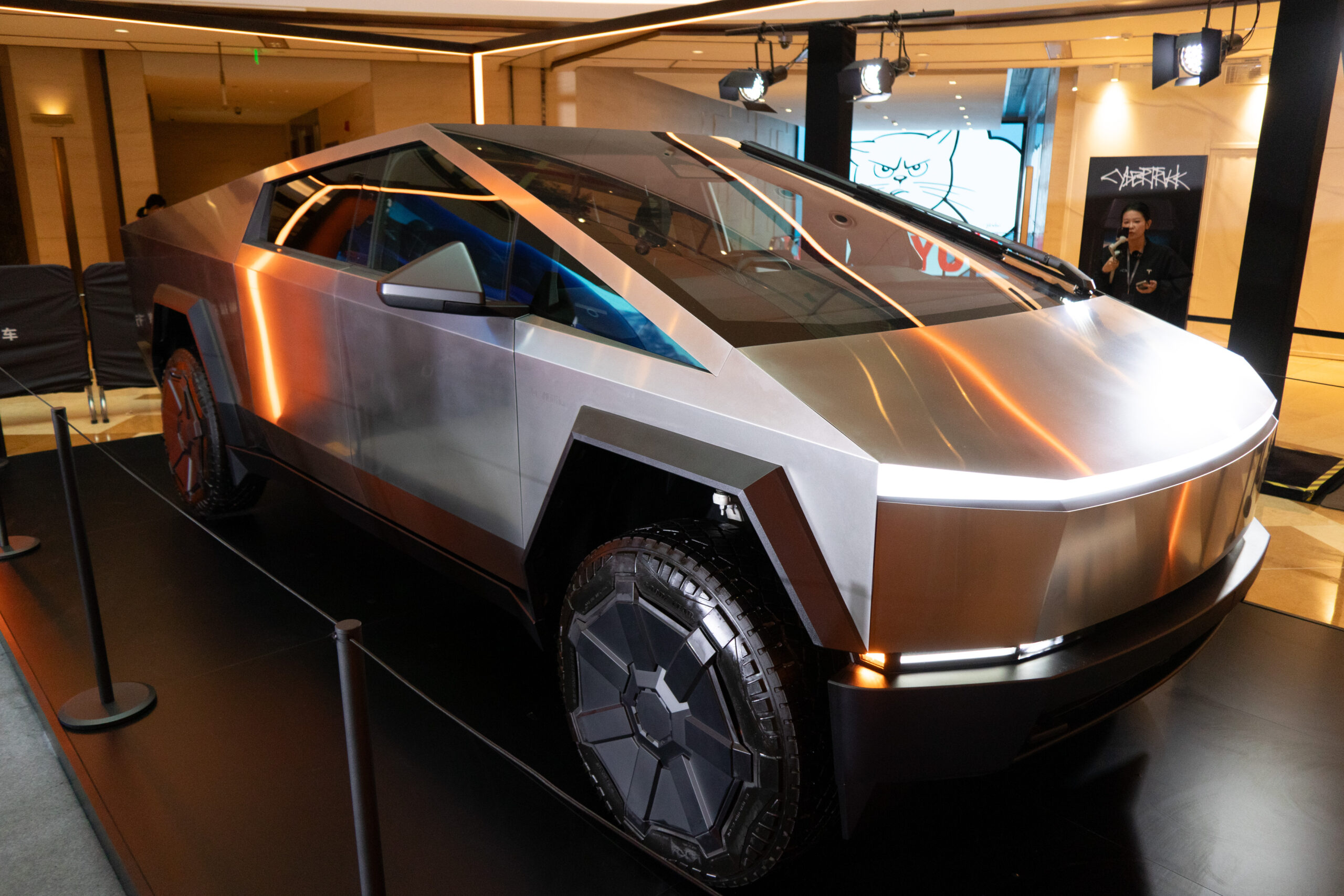
While $100,000 or more for a Cybertruck may seem like a lot to average people, that is roughly equivalent to a single AGM-114 Hellfire missile for the U.S. Army. Each one of the Army’s new Infantry Squad Vehicles, which are militarized derivatives of the commercial Chevrolet Colorado ZR2 pickup truck, has a unit price of around $150,000, according to the service’s budget documents.
In other words, an uncrewed vehicle that costs anywhere near the lower six-digit price figure with Cybertruck’s potential capabilities would be an absolute steal in military procurement terms. But it goes beyond that, especially when it comes to the sustainment of such a vehicle, and leveraging a mass consumer product to realize efficiencies that would be impossible to achieve with a similar vehicle built specifically for the military. We will get deeper into just how big of a deal this is in a bit.
Regardless, leveraging this unique opportunity, Cybertruck would be fully attritable — losing them in combat would not be a big financial or operational issue. They would be relatively easy to replace and comparatively inexpensive to do so. As such, troops could employ them accordingly on high-risk missions, which would open up new tactical possibilities.
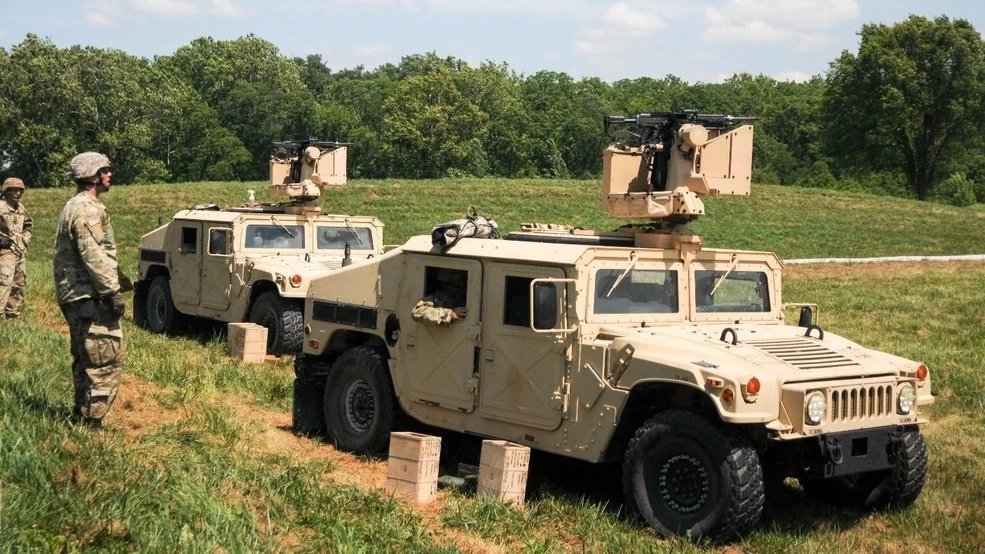
While a beefed-up military Cybertruck drone would have a wide number of applications, everything from armed scouting to acting as a forward weapons platform, to resupplying troops near or on the front lines, to pulling sentry duty to base perimeter patrol, to casualty evacuation, and more, it would not be meant to take the place of a tracked vehicle or even a substantially heavier armored truck. It would work from roads, semi-improved trails, and some off-road areas, similar to a Humvee, with the more challenging rough terrain work being left to more complex and purpose-built systems.
So we are talking about a highly adaptable light utility UGV here, not an unmanned tank.
A military Cybertruck with a human driver
A crewed Cybertruck could also be a very attractive electric light utility vehicle for the military for certain applications, but unlike its uncrewed counterpart, front-line operations probably wouldn’t be one of them.
Like its theoretical unmanned counterpart, the manned Cybertruck’s tough suspension (and potential for upgrades), decent endurance, and ability to sit ‘on station’ for long periods without consuming any fuel could be useful for lots of tasks. This is especially true for those that happen on base, like security, maintenance, operations, and other utility needs.
Adding additional armor to Cybertruck seems like it would be possible as its stainless steel ‘exoskeleton’ (unibody) already provides some protection against subsonic handgun caliber bullets, which isn’t really relevant beyond a novel feature when it comes to real armor, but it could be a good base. Adding additional protection may be quite easy to do considering the vehicle’s big, flat (or at least close to it) panels. Anything having to do with mine resistance is probably a non-starter due to the vehicle’s flat battery-laden floor/chassis that underpins it, but that wouldn’t be needed for these applications.

Regardless, Cybertruck has a big cabin with seating for five and a nice bed for hauling things or attaching modules to. It can also pull a lot of weight — up to 11,000 pounds. The fact that it consumes no gas would be attractive to the military that is trying to reduce its reliance on fossil fuels and the logistical burden that goes with it. Cybertruck’s low center of gravity is also a big plus for manned operations, limiting deadly rollover crashes.
Many of the negative perceived aspects of the Cybertruck for civilian uses, such as its very rigid construction, including much negative speculation about its crash and pedestrian collision safety, unfounded or not, would not matter to the U.S. military. This is especially true for uncrewed types, but it’s also true for crewed ones, too. Nor does the aforementioned cost. The fact that the Cybertruck has gone up in price considerably, and it could climb even more, is not relevant to the DoD compared to what it is getting. It is dirt cheap when it comes to Pentagon procurement dollars. In fact, Cybertruck is competitive with the basic (non-up-armored) Humvee’s price tag — a very austere 40-year-old design.
Other supposed issues, like discoloring stainless steel panels, wheel covers that rub on its tires, or its overall size would also have no impact on military applications.
Many of the same features that are ultra-relevant to a UGV Cybertruck are also relevant to a crewed military Cybertruck. The vehicle’s databus and power handling system, its open architecture potential, four-wheel steering, and its sturdy design and off-road capabilities, can be improved for a military variant, to name some of them.
Above all else, buying Cybertruck in a crewed configuration would be even more ‘off-the-shelf’ than an uncrewed one.
Economies of scale by the Cybertruckload?
Taken as a whole, all these attributes read like a punch list of what the U.S. military is looking for in its future vehicles, and especially UGVs. All that critical development has been paid for already by Tesla, not the DoD. This is a huge deal. Massive amounts of money have been poured into this platform by Tesla and the DoD could potentially step in to leverage all that R&D with a nearly off-the-shelf base platform. This is largely unheard of for an emerging capability set.
Now for the most enticing part of all that we touched on earlier. If Cybertruck reaches full-rate production, with many thousands being built a year at whatever cost, such an exotic package of relevant technologies will be available with a vast sustainment infrastructure and continued OEM support that is built for the masses, not a boutique military contract. This is rarely the case with vehicles specifically built for the U.S. military and it would drastically lower operating costs of these vehicles in any configuration.
Remember, the unit and development costs are just the cover charge for any weapon system or military vehicle. Even more money can be spent, and by a huge factor in many cases, over the life of the platform to just keep it running and improve it incrementally. Having a fleet of relatively highly advanced military vehicles that share the same platform with thousands of vehicles driving on public roads every day is just such an incredible opportunity in efficiency.
As to the big question of whether Cybertruck will actually reach mass production, The War Zone asked Kyle Cheromcha, editor of TheDrive.com, and Patrick George, editor of InsideEV.com. Here are their takes:
Kyle: “Tesla has spent the last four years trying to figure out how to build the Cybertruck at scale, and even though the manufacturing challenges are immense, so were those surrounding the Model 3 ramp-up six years ago. I expect it to be rocky and full of problems for at least the first two years, but ultimately achievable. The bigger question mark to me is sustained consumer demand once the early adopters get their fill.”

Patrick: “If Tesla had made a truck with a lot of these internals and specs with a ‘conventional’ steel/aluminum body like their other cars, I think that would’ve been absolute nightmare fuel for GM and Ford. But that stainless steel body is a notoriously difficult material to work with. Even Musk has tried to temper expectations around production for the Cybertruck—he’s said they ‘dug their own grave’ by choosing to go stainless. Musk is, if nothing else, the ultimate Hype Man. I don’t often hear him being that circumspect.”
“More than likely, what we’ll see are the most expensive examples of the Cybertruck rolling out slowly over the next few years, and maybe more entry-priced ones coming in 2026 or so as they get things dialed in. I think going with stainless steel was ultimately a misfire here. But Tesla’s proved me wrong before. This company has a unique way of just figuring stuff out, and hitting back twice as hard when it’s knocked down. I would not put it past Tesla to figure stainless steel out, somehow. That, or it will be a costly and complex mistake like the Model X’s Falcon Doors were. I’m not sure I see an in-between there.”
Even if the Cybertruck were to not make it to high-rate civilian production, the military could step in and become the definitive customer for the platform. There is scale in that alone and price, once again, would not be such a factor considering the platform’s level of pre-development the DoD could receive in return.
Evolving the systems and upgrading them over time is another factor. Tesla will be doing this regardless of military interest, assuming Cybertruck sticks around for a while. The military can leverage this developmental pipeline. This also works the other way, with innovations for Cybertruck from the military side bleeding into the civilian side, when appropriate, creating virtuous, parallel innovation cycles.
Of course, as it sits now, Tesla is looking at extreme demand, at least in the near term, for its most ambitious vehicle. The ability to ramp up Cybertruck production remains a key question surrounding its potential success. In other words, if the military were to become a customer, Tesla would have to ensure it would be able to support its production demands. Even the DoD exploring Cybertruck’s attributes on a more limited or even experimental scale would be highly logical in the immediate term, if Tesla were willing to participate. This also is a big unknown. Would Tesla be ok with the weaponization of their vehicles?
Some of Elon Musk’s other companies, namely SpaceX, are heavily supported by the Department of Defense and that relationship could expand further in unique ways. The company’s President, Gwynne Shotwell, even noted that they would be open to more direct weaponization of their capabilities in defense of the United States. Would Tesla be a different story?
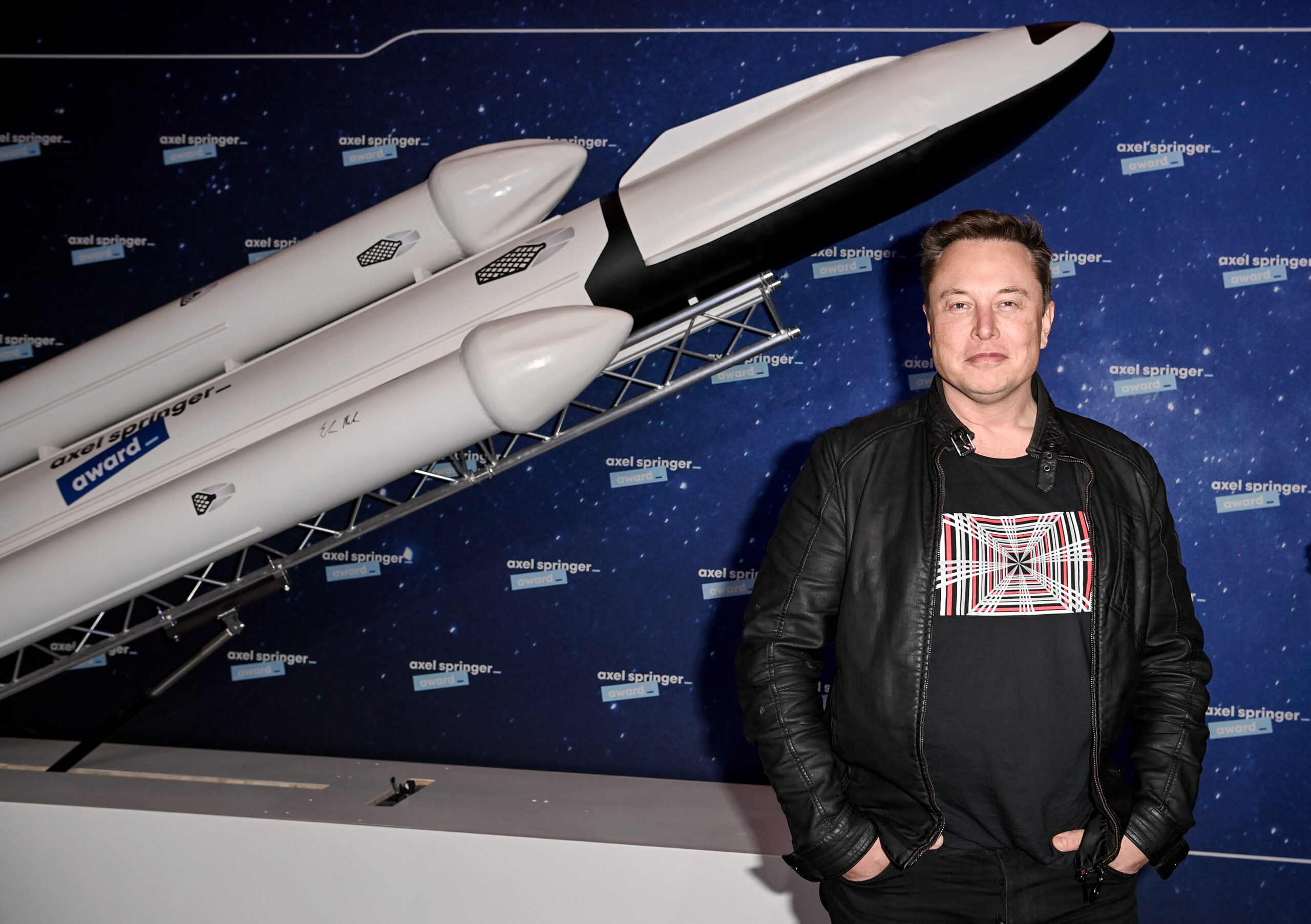
Musk famously shut down Starlink for Ukraine in areas where it was being used for offensive attacks on Russian targets in Crimea. However, this seems to have been more of a concern out of starting World War III than anything else. Musk’s Starlink terminals are otherwise widely used by Ukrainian forces and the U.S. military is experimenting with it too.
While turning the Cybertruck into a hardy war wagon filled with elite troops may not make sense, the future of combat is very much unmanned. Considering the Cybertruck is all about Musk’s vision of the future and what it should look like, having no driver at all for a military variant and maximizing its utility without the need for creature comforts, should fit into that vision, as it should with Tesla’s overreaching self-driving goals.
Maybe, in the end, Tesla’s greatest achievement with its controversial Cybertruck may just be that it actually built the best ‘practical (sort of) to tactical’ opportunity the Defense Department has been faced with in years.
Contact the author: tyler@twz.com
